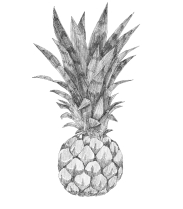Pineapple

- The name “pineapple” comes from Tupi-Guarani (the language spoken in Brazil before the arrival of the Portuguese), where “nanas” means “delicious fruit”.
- The first mention of the pineapple is found in literature in the mid-16th century – it is described in the book Chronicle of Peru.
- In fact, the pineapple is not one, but many small fruits attached to each other.
- It takes 3 years for a pineapple to fully ripen, so these fruits are quite expensive.
- The fruit is the main source of bromelain, an enzyme that helps the body digest proteins. This makes pineapple good for digestion, and it is often included in weight loss diets.
- Pineapple is used as a raw material for making fabrics due to the strong fibers that make up its leaves.
A glass of pineapple juice can relieve motion sickness when traveling by air or water. - Pineapple leaves are often used in the construction of homes in tropical regions as natural roofing materials that provide protection from rain and sun.
- Pineapples do not ripen after they are harvested. This means that if a pineapple is picked unripe, it will never reach its full flavor and sweetness like other fruits can.
- Pineapples are still picked by hand – extremely prickly and capricious plants do not tolerate other methods that technological advances offer.
- The pineapple is painted on the coats of arms of Jamaica, as well as Antigua and Barbuda (see interesting facts about Jamaica).
- Pineapples are not only used to make candies, fruit salads and jams, but also pineapple wine.
- Pineapples are able to regenerate: if you cut off the top part of the fruit with the stem and plant it, you can grow a new pineapple plant. This process can take several years, but it’s an interesting experiment and a way to create a tropical oasis at home.